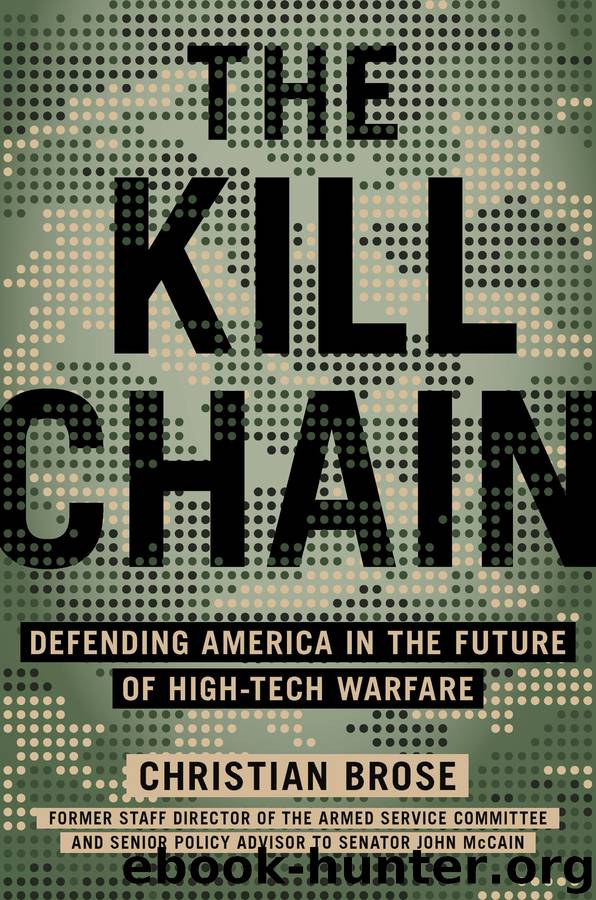The Kill Chain by Christian Brose

Author:Christian Brose [Brose, Christian]
Language: eng
Format: epub
Publisher: Hachette Books
Published: 2020-04-21T00:00:00+00:00
There are no ideal solutions when it comes to warfare. The use of violence inherently involves deep levels of uncertainty, risk, and unappealing trade-offs—something that both the opponents of and proponents for military use of intelligent machines must always remember. It is guaranteed that both humans and machines will err in the conduct of war. More intelligent machines will still make mistakes; they will just make different mistakes. Some of those mistakes could be less costly than those that humans make, but some could be more costly. This becomes especially problematic if, as opponents of autonomous weapons fear, humans use those weapons over time for more expansive purposes and in less proportionate and discriminate ways. This is a legitimate cause for concern, and it highlights the critical question at the center of our current debates over artificial intelligence and warfare—whether humans could ever train and test intelligent machines enough to trust them to close the kill chain without a person in the loop or directly in control.
I believe we can. In fact, we already have. But even framing the issue in this way does not readily convey the vast extent to which human choices and values are engineered into the deepest recesses of even those machines capable of acting with the greatest degrees of autonomy.
Lethal autonomous weapons have existed for a long time. Such systems, with varying degrees of capability, are currently in use by at least thirty different states. The US Navy, for example, has used the Phalanx gun and Aegis missile defense systems to defend its ships for decades. Though far less capable than the intelligent machines of today and tomorrow, these systems can be switched into a fully automatic mode that enables them to close the kill chain against incoming missiles without human involvement. The decision to trust those machines to do so was born of necessity: it was unlikely humans could respond fast enough to counter incoming missiles. That inability was deemed a greater danger than the option of turning the kill chain over to a machine that could shoot down missiles in time-sensitive situations more effectively than humans could.
The intelligent machines being developed today are far more sophisticated than the Aegis system, but even if they were permitted to close the kill chain on their own, they would not be choosing to do whatever they want. To the contrary, a machine’s ability to operate autonomously is confined by boundaries that humans have established. Its ability to identify targets is limited and based on algorithms that humans have written, trained, tested, and come to trust as effective. The machine’s ability to use violence against targets is further constrained by parameters that humans have defined, such as how much and how often the machine can fire. And the only way the machine is ever sent into combat in the first place is because humans have made the decision to release it from their control—a decision for which they are ethically and legally accountable.
That process of establishing accountability
Download
This site does not store any files on its server. We only index and link to content provided by other sites. Please contact the content providers to delete copyright contents if any and email us, we'll remove relevant links or contents immediately.
The Secret History by Donna Tartt(16622)
The Social Justice Warrior Handbook by Lisa De Pasquale(11489)
Thirteen Reasons Why by Jay Asher(7788)
This Is How You Lose Her by Junot Diaz(5770)
Weapons of Math Destruction by Cathy O'Neil(5036)
Zero to One by Peter Thiel(4824)
The Myth of the Strong Leader by Archie Brown(4789)
Promise Me, Dad by Joe Biden(4447)
Beartown by Fredrik Backman(4415)
Stone's Rules by Roger Stone(4415)
How Democracies Die by Steven Levitsky & Daniel Ziblatt(4398)
The Fire Next Time by James Baldwin(4342)
100 Deadly Skills by Clint Emerson(4076)
A Higher Loyalty: Truth, Lies, and Leadership by James Comey(4032)
Rise and Kill First by Ronen Bergman(4012)
The David Icke Guide to the Global Conspiracy (and how to end it) by David Icke(3881)
The Farm by Tom Rob Smith(3872)
Secrecy World by Jake Bernstein(3782)
The Doomsday Machine by Daniel Ellsberg(3730)
